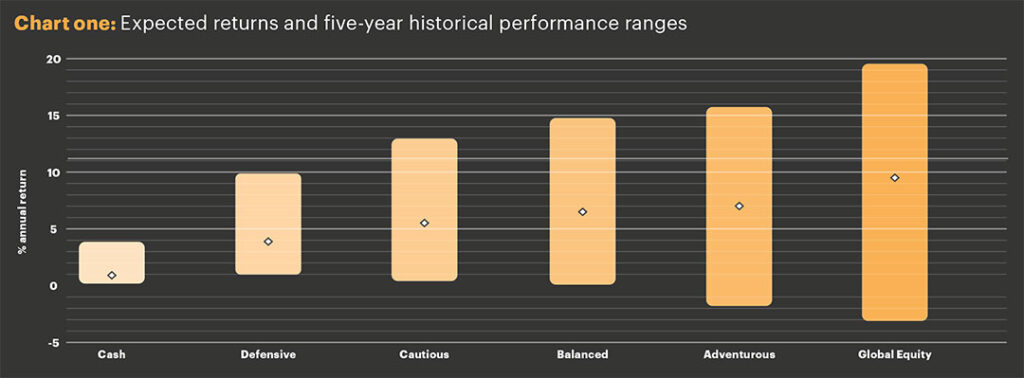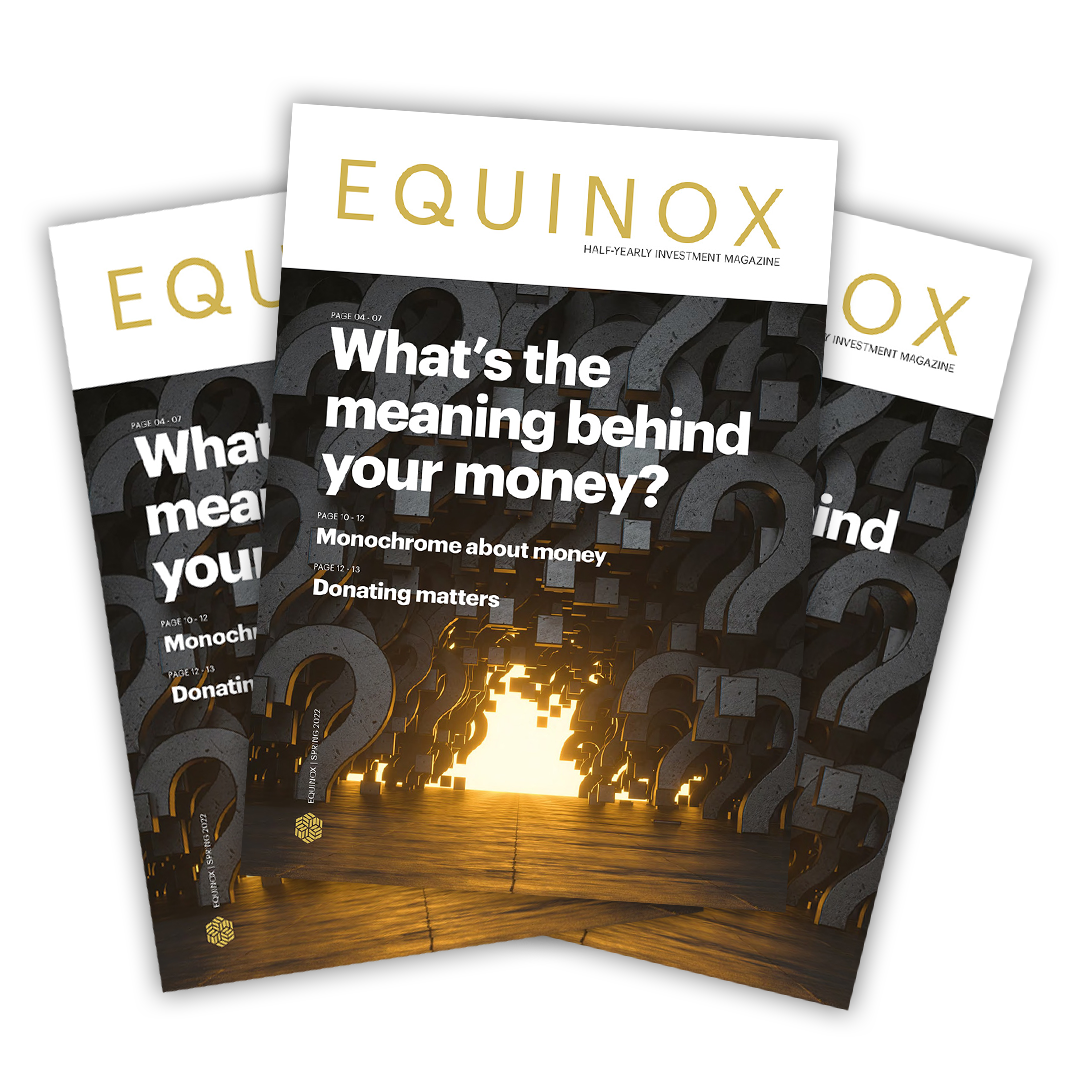This article is taken from our spring 2021 edition of Equinox. You can view the full version here.
When speaking to clients, I’m always struck by the many different ways our service is perceived. The sheer variety of client situations and desired outcomes is fascinating. There is however, one underlying constant that sits at the heart of what we do: the need to create a personalised investment portfolio to meet a range of goals and objectives.
Our investment process was built around this requirement and is fundamentally very simple. Stage one is all about getting to know the client and understanding their circumstances, objectives and views on risk. This will generally include building a cash flow plan along with a timeline of important milestones and capital requirements.
In stage two, the financial planner uses this information to construct a tailored investment portfolio aligned with these goals. This will include selecting the right products and keeping everything tax efficient.
Although our process has withstood the test of time, we are always looking for ways to improve what we do. Recent innovations within our investment fund range have presented the opportunity to evolve our approach and create a new style of portfolio, with an even stronger link to the client’s specific goals.
Fund innovations
Before we explain this change it’s worth rewinding back a year to when we were managing three funds.
Our Cautious, Balanced and Adventurous Portfolio Funds meet most client needs, but there were sometimes situations which called for higher or lower risk alternatives. For this reason, Mike Deverell and the investment team created two new funds to allow for even greater flexibility.
June 2020 saw the arrival of our Global Equity Fund, enabling us to target higher returns for clients where short-term volatility is not a concern. Then, February 2021 saw the launch of our Defensive Fund, with almost the opposite objective, targeting stable returns with low levels of volatility.
These new funds really do provide an extra dimension when designing portfolios. The full impact of this can be seen in chart one.

Here, you can see the original three funds alongside Defensive and Global Equity (plus cash for an additional comparison). The diamond shows the expected annualised 10-year return for each fund (net of investment fees). The bar shows the range of historical returns (on a 5-year annualised basis).
The chart clearly shows that as the potential return increases, the risk and range of likely returns (based on history) also increases. It’s also easy to see just how polar opposite the two new funds are. Defensive is likely to be relatively stable with low expected returns and low risk. On the other hand, global equity will introduce high levels of volatility, but with it the potential of much higher returns.
In other words, we now have an enhanced investment toolkit with a broader range of options. More importantly however, we have been able to create a completely different style of investment portfolio. We call this new approach horizon planning.
A sense of purpose
Returning to our investment process, the key to building the perfect portfolio is by fully establishing the purpose of the money. This will include all sorts of different requirements, such as when capital might be needed and whether an income should be taken. The first step of our new approach is to record these requirements on a timeline, split into three horizons:
- Short term: typically the first five years
- Medium term: usually the subsequent twenty years
- Long term: everything thereafter (so, typically twenty-five years plus)
Each of these horizons is then assigned a pot of money from the portfolio:
- Pot 1: Reserve (short term)
- Pot 2: Income (medium term)
- Pot 3: Growth (long term)
These pots can then be invested at an appropriate level of risk corresponding to the horizon timescale.
The horizon planning process
In terms of how this process works, we tend to calculate the size of the reserve and income pots first, with any remaining capital being allocated to the growth pot. This way, we can ensure that the most immediate needs are met first.
Another important point is that a client’s personal cash holdings would form part of the reserve. The portfolio we manage would then be built on top of this.
Pot 1: Reserve
Acting as the foundation of the strategy, the aim of this pot is to secure an element of capital to provide stability and keep it accessible regardless of markets. The size of the pot is usually based on five years of income needs (covering the short-term period) plus any additional capital requirements.
For example, a client with a portfolio income of £50,000 would have a base reserve pot of £250,000.
We would then add other capital requirements to this such as a new car for £20,000 in a year’s time, plus maybe £50,000 in four years’ time for an extension. In this case, the reserve pot would be £320,000.
This figure might still be adjusted if the client has a strong preference for a higher or lower reserve. Once the size of the pot has been agreed, we would then look at how much should be retained in cash and how much should be invested. We would always recommend a minimum of one year of income is kept in cash (sometimes two) plus any immediate capital requirements.
In the above example, a possible solution could be for £70,000 to be held in cash by the client (one year of income plus the car funds), with the balance of £250,000 being invested into our new defensive fund.
Pot 2: Income
The purpose of this pot is in the name; to fund regular income and portfolio withdrawals. It also provides a home for medium-term capital requirements. The size of the pot is calculated in the same way as the reserve but using the longer timeframe of the medium-term horizon.
Continuing with the above example, the starting point for the income pot for a 20-year horizon would be £1,000,000. Again, we would add any other capital requirements such as the possible gift of £100,000 to a child in around ten years to help with a potential house purchase. In this instance, the income pot would be £1,100,000.
This would be invested in line with the client’s normal risk profile, usually in our Cautious, Balanced or Adventurous Funds (or perhaps an appropriate blend). In this case, let’s assume that a balanced approach is selected.
Pot 3: Growth
Once capital has been allocated to the reserve and income pots, the surplus can then be invested into the growth pot. Remember that we are talking very long term here, usually at least 25 years. In fact, in some instances, the capital allocated to this pot might never actually be needed in the lifetime of the client. This presents the opportunity to use one of our higher risk approaches, such as our new global equity fund.
To finish our example, let’s say the client in question had assets for us to consider totalling £2,000,000. In this instance, the final portfolio could look like this:
- Reserve: £320,000 (£70,000 cash, £250,000 defensive)
- Income: £1,100,000 (invested in balanced)
- Growth: £580,000 (invested in global equity)
This example is for illustrative purposes only. There are likely to be multiple possible solutions for each situation which is, of course, what makes this approach so tailored to a client’s personal circumstances.
The outcome
The outcome of our horizon planning process is a strategy to allocate capital into each of the three pots. There is still much to be done however, as we will need to work out which products to use (ISA, pension, general investment account, etc) and how to keep everything tax efficient. We are now very much in stage 2 of our investment process.
A good example of this is with pensions. These are often suitable for long-term growth if the owner is young (due to access restrictions). In this instance, the pension could be a good place to hold the growth pot. Fast forward to retirement and the pension might well form part of the client’s income strategy. At this point, the pot would revert to income, possibly with an element of reserve to provide stability.
A couple of quirks
No income needed
If no income or capital withdrawals are expected in the short- and medium-term, then there may be no need for an income pot. We might still recommend creating a reserve pot in order to cover unforeseen events and provide flexibility. At the very least, a cash emergency fund should always be retained. The size of the reserve pot in this instance would be based on discussions about risk.
Unsustainable income
Where a client has a high income need from a relatively small portfolio, it could be that there isn’t enough capital to create an income pot of the requisite size. In this situation, we would explore the potential problem using cash flow modelling and estimate how long the capital might last. The growth pot would obviously not be needed in this scenario.
Finally
It should be noted that a horizon planning approach is not necessary for every client or situation. Our financial planners will always discuss our full range of options and then recommend the most appropriate approach.
Disclaimer: The content contained in this blog represents represents the opinions of Equilibrium Investment Management LLP (EIM) and Equilibrium Financial Planning LLP (EFP). The commentary in no way constitutes a solicitation of investment advice. It should not be relied upon in making investment decisions and is intended solely for the entertainment of the viewer. Past performance is never a guide to future performance. Investments may (will) fall as well as rise and you may not get back your original investment.’


